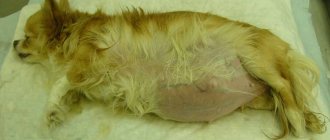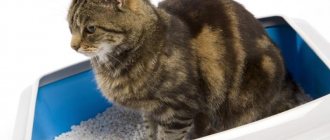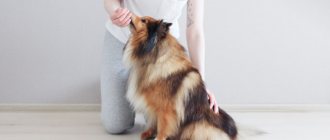The birth of babies is a special moment in the life of every owner and his pet. Often, first-time owners begin to panic during their dog's labor, finding themselves unable to help when needed. To overcome your fear and deliver a dog at home, you just need to know a few simple things. The main thing is not to worry and be well prepared.
How to understand that childbirth is near
As the cherished day approaches, the bitches' behavior changes. They become more excited, fussy, looking for a place where the process will take place. Over the course of one and a half to two weeks, the stomach begins to gradually change. This happens because the fetuses are approaching the birth canal. Visually, it seems as if the stomach has shrunk a little - this is a natural process, there is no need to worry.
At the same time, the expectant mother begins to lie down more and more, since it is already difficult for her to walk. It's time to find a place where the process will take place and learn how to deliver a dog.
When there are only a few days left before whelping, mucous discharge from the vagina appears. This is how the cork comes out, which prevented the fruits from being born ahead of schedule. Most often, the plug comes off unnoticed.
Sometimes discharge also appears from the nipples - especially if the bitch is pregnant not for the first time. This stage can be easily determined by the characteristic behavior of the animal. She licks herself often and spends quite a lot of time doing this, and stains remain on her bedding or diaper.
Signs of the onset of labor in a dog and the process itself are difficult to miss. A few hours before giving birth, the pet’s water breaks, which contained the fetuses. This means that she will give birth very soon, which means it’s time for the owner to prepare.
Preparatory activities
Owners prepare well in advance for the birth of their beloved dog, two weeks before the expected date.
Place of stay
Arrange in advance the place where the “mommy” and the puppies will stay. For small dogs, a purchased house or a regular box with a roof and an entrance is suitable. Large dogs can actually build a box from scrap materials. For example, from boards or plywood and cover it with old blankets.
In any case, the “dog nursery” should be located in a secluded and safe corner, protected from drafts and irritating factors.
Preparing for childbirth
Experienced breeders have completely different views on where and how a dog gives birth: some are sure that a pet should whelp exclusively on a bed, sofa, or at least on soft bedding. Others immediately put it in a spacious box in which the mother and her children will spend the near future.
What you will need
Be sure to prepare a first aid kit for the mother in labor or babies. It should contain the following:
- iodine and brilliant green;
- antiseptics (medicinal alcohol or peroxide) - they will come in handy when you need to treat instruments or hands;
- in case the bitch does not gnaw the umbilical cord herself, it is better to get special scissors;
- clamp;
- syringes;
- cotton wool, bandages, gauze and other dressing materials;
- suction in case puppies are born in a bubble and cannot breathe normally;
- Oxytocin injections are helpful if your dog is not having contractions.
Clean cloths and disposable diapers never hurt. It is worth stocking up on water so that the bitch can quench her thirst during childbirth.
It would be ideal if one of the family members takes a short vacation during the whelping period and takes care of the mother and her babies. This can be called a necessity if the dog is giving birth for the first time.
Where to place the dog
Of course, a bitch will give birth in any conditions, but decent owners still take time to arrange a comfortable and convenient nest. The bed is not the best place for dogs and puppies, as the animal will not find it very secluded. Rapidly grown puppies will begin to crawl and fall, which will lead to serious injuries to fragile babies. In addition, discharge during childbirth can stain everything, including the mattress - so this option is not the most hygienic.
Almost all owners prefer to place their pet in a box covered with soft material. The puppies will not have the opportunity to get out, which means they will remain under the strict supervision of their mother. Another plus is that during the birth process the dog has the opportunity to rest its hind legs on one of the sides, and this will greatly facilitate contractions.
There are several rules that need to be followed when arranging a family house for a dog.
- Choose a box based on the size of your dog. A box that is too tight is just as bad as one that is too spacious. The bitch should fit in it herself, and also leave room for the puppies.
- The sides of the box must be no lower than the height of the animal in a lying position.
- Cover the bottom with a light cloth. Thanks to this, you can control discharge before, during and after childbirth. Do not forget to promptly change the soiled diaper to a dry one.
- It is best to place a mattress or a sheet of thick foam rubber under the diaper. This will allow the mother to sit comfortably inside and reduce her discomfort.
- Prepare a second, smaller box. Puppies must be placed there before giving them to their mother. Place something warm inside the box - a heating pad wrapped in cloth.
Be sure to let your dog get to know your box beforehand. Let her get used to it. If this is not done, the animal will find its own secluded place, to which a person will most likely have difficulty accessing. And the presence of the owner is mandatory during dog births at all times.
Place the box in a visible place and put some treats in it. If your pet does not get into it for a long time, pay attention to whether you have chosen the right size and bedding.
Caring for young animals in the first minutes of life
The dog takes care of the offspring on its own, licking the puppies and pushing them towards the nipples. But if she is weakened or does not know what to do due to the fact that she is giving birth for the first time (refuses to recognize puppies, is afraid of them), a person can temporarily replace her:
- newborn puppies are taken out of the box;
- make sure that they are all breathing freely;
- wipe the wool with a soft cloth soaked in water;
- wipe dry with a towel;
- placed on the dog's nipples.
Important ! The pet may behave aggressively, preventing the puppy from being picked up. In such a situation, simply install a heater next to the box so that the wet puppies do not freeze.
Childbirth process
As a rule, dogs cope on their own without human help. Regardless of breed or size, the scenario is always the same. However, the owner must be present during the birth to reassure and comfort the animal, as well as to prevent complications in time and call the veterinarian.
How long does labor take?
It all depends on the stages of childbirth in dogs. It happens that each stage goes quickly, and the whole process takes up to 6 hours. Sometimes labor drags on for almost a day, and this is also considered normal. Anomalies are usually recognized not by the total duration of labor, but by too long a time interval between stages.
It’s difficult to say how long a dog’s labor lasts – this indicator is purely individual. It depends on the number of fruits, the condition of the bitch and her age. The whole process takes from three to twenty hours, but in most cases everything ends after 7-9 hours.
If there are a lot of puppies in the stomach, this does not mean at all that the process will be drawn out. Rather, on the contrary: the fewer cubs, the longer the process. In addition, the duration of pregnancy depends on the number of puppies.
The most difficult thing will be the birth of your first puppy. The rest of the babies will be born faster. The interval between puppies can last up to half an hour, but the fewer puppies, the shorter the interval.
What should cause concern is the large time gap between the appearance of puppies - normally it is a maximum of an hour. If the next baby does not appear for 2-3 hours, you need to call a veterinarian.
If labor is delayed, it is worth inviting a veterinarian to your home, because the puppies inside the uterus can simply suffocate. Also, the cause of protracted labor can be simple fatigue of the mother. To prevent this from happening, veterinarians recommend giving the animal strong tea with sugar. It stimulates the cardiovascular system and gives strength.
Description of the process by stages
Contractions begin first. At first they are invisible and very weak, but over time they become more frequent and intensify. The contraction period lasts on average 6-12 hours, it is not difficult to determine: the bitch breathes frequently, can whine and rush about.
Then the first attempts occur. The bitch takes a comfortable position for childbirth. At this time, the fetus is already approaching the birth canal. At this moment it is better not to interfere: the expectant mother herself will take the position and begin to push the puppy out.
Then a dark purple bubble appears. At this point, inexperienced owners begin to get scared and sound the alarm. In fact, there is nothing to be afraid of here: it is from such a bubble that puppies emerge. During the entire process, it becomes larger and smaller until the bitch pushes it out completely.
Now the puppy himself appears. It is born in a shell, which the mother bites through so that air can flow to the baby, after which it gnaws the umbilical cord. If this is the first pregnancy, then the new mother sometimes does not pay attention to the baby - in this case, you need to take matters into your own hands and first get rid of the bubble, and then cut the umbilical cord.
Make sure that after each puppy, its placenta comes out. Sometimes she comes out after the next baby. When it's all over, count the number of puppies and afterbirths. If something does not match, be sure to show your pet to the doctor - she will need to remove the undelivered placenta so that sepsis does not start.
After the baby is born, the mother will begin to care for it: licking it to remove mucus and massaging it with her tongue to improve blood circulation. After that, he will find the nipple and drink milk. If the puppy has any problems, point him in the right direction or place him near the nipple.
Features of childbirth in different breeds and sizes
Some breeds of dogs require mandatory human assistance during childbirth, up to a cesarean section - these are brachycephalic dogs (pugs, bulldogs, Japanese chins, Pekingese, etc.), which begin to choke during strong contractions and attempts. Successful births in these dogs at home are extremely rare - it is better to consult a veterinarian.
The second risk group by breed is mastiffs. This is explained by the weak heart of giant animals and the frequent occurrence of multiple births. Childbirth can drag on for a long time, since the uterus in the middle of the process simply loses its tone and refuses to push out the puppies. Childbirth in mastiffs of all categories must take place strictly under the supervision of a veterinarian.
In general, births in large dogs can be complicated by multiple births. If the ultrasound showed ten or more puppies, it is better not to risk it and ask the veterinarian to be present at the birth.
The third risk group is dwarf breeds, especially toy terriers and Yorkshire terriers. The fact is that the fetuses are too large for such dogs, and they often experience obstruction of the birth canal.
In addition, dogs of miniature breeds have a weak maternal instinct. If an experienced dwarf breed bitch takes good care of the babies, a primiparous dog is unlikely to understand what needs to be done. Here the owner will have to make an effort to care for the puppies for the first few days.
Childbirth is easiest for large dogs and medium-sized dogs. Both yard and purebred females up to 50 cm in height produce up to 6-8 puppies and easily survive the entire birth process.
How many puppies should there be?
Quite often, dogs in labor need help from the owner. Even if the birth process proceeds without complications, it is important to check that the dog has given birth to the last puppy.
During the birthing process, the dog experiences anxiety and contractions. The first sign that a dog has finished giving birth is its calmness and complete immersion in caring for its offspring. The average duration of breaks between the appearance of puppies is usually 20–30 minutes. However, it happens that the dog takes longer breaks.
If the break is prolonged, it is important to make sure that labor is over and the dog has given birth to all the puppies. To avoid being caught off guard, it is advisable to know how many puppies you are expecting. To determine the number of embryos, you can contact a veterinary clinic, where an ultrasound examination or x-ray will be performed. The most accurate result can be expected if the study is carried out at 50–55 days of gestation.
Important! In the experience of many owners, ultrasound examination is not always accurate. Veterinarians often insist on x-rays, which can more clearly show the number of embryos.
When Your Dog May Need Help
Not in every case the woman giving birth needs your help. Of course, it’s good if you help clean the babies from blood and mucus, but a healthy animal can handle this quite well. The only exception can be when the female gives birth for the first time.
Don't let your guard down. At any moment, the bitch may develop complications, and then only you can take control of the situation. For example, when your pet’s water breaks but contractions have not started, she needs to be given oxytocin. It stimulates the uterus, and it begins to contract normally. You cannot give such injections on your own - first call your veterinarian and get a consultation. He will assess the situation and recommend a dosage.
You should urgently call a veterinarian if bleeding begins - this can be understood by the scarlet, increasing discharge from the vulva. Green-brown discharge should also alert you if the puppies are delayed in appearing.
If the female ignores the umbilical cord and bladder of the newborn, your task is to deal with them yourself. In a stressful situation, the dog is simply confused and does not know what to do. Every second counts: you need to cut the umbilical cord using scissors with round edges, having previously disinfected them.
If, after the bubble has been removed, the baby still does not begin to breathe, use suction and remove all mucus and fluid from the respiratory tract. Be careful not to injure him - babies are very fragile in the first few days of life.
The bitch may be too tired to attend to her children's hygiene. Then you will have to take care of this. Soak a towel in warm water and dry all newborns thoroughly. There should be no mucus or bubble residue left on them.
After all have been born, licked by the mother, or washed by you, place them next to the bitch's nipples. After birth, they need to eat and gain strength.
Inducing labor in a dog
Only a veterinarian can tell you whether your pet needs stimulation or not. If you risk making such a decision on your own, there is a high probability that the procedure will only be harmful: early stimulation can result in serious consequences, including uterine rupture. There is a need only when the bitch is completely ready for childbirth, but there are no contractions. Ideally, stimulation should be carried out in a hospital under the close supervision of doctors.
Medication
With drug stimulation, the bitch is given an injection or a drip is placed, for example, with ascorbic acid, glucose solution or some other stimulants. Quite quickly they begin to act, and the birth process begins.
Corporeal
Another way is bodily stimulation. To use it, you do not need to give injections or even go to the hospital. This stimulation implies a type of massage that helps the fetus to be born faster and makes the process easier for the mother. Massage your stomach from top to bottom. Don't press too hard, use gentle movements. You can massage the skin near the vagina. This will relax it a little, which means it will make it easier for the fruit to come out.
Narrow pelvis
The narrowness of the dog's birth canal can also cause complications. The cause of a narrow pelvis is either a deviation in the anatomical structure of the dog’s skeleton, or rickets or pelvic injuries suffered in childhood. Although rickets is extremely rare, since there are a huge number of special medications designed to protect the puppy from this disease, it is worth keeping in mind that this deviation does occur.
If you have reason to think that your dog may have a narrow birth canal, conduct appropriate research, and if the diagnosis is confirmed, the right decision would be to refuse mating altogether.
If a dog gives birth with a similar pathology, during the process of the bitch’s attempts, the puppies’ membranes appear for a while from the loop and disappear as soon as the series of attempts is completed. If the dog fails to give birth, she must have a caesarean section. Ineffective attempts and contractions not only tire the dog, but also have an extremely negative effect on the muscles of the birth canal: they become tired and swell, which can lead to rupture and prolapse of the vagina. Don’t tempt fate: at the slightest suspicion of this pathology, call a doctor, his help is necessary!
Condition after childbirth
After the process is completed, the bitch will continue to discharge for some time. If everything went well, they will be brown in the first few hours, but over the next few days (or even weeks) they will be white or yellowish. Bloody or any other discharge with an unpleasant odor is a clear sign of pathology, which means a reason to immediately consult a doctor. This may mean that the pet has some kind of injury or that the placenta remains inside.
If the birth was successful, after a few hours it is necessary to change the bedding of the mother and puppies and offer the bitch a drink. Feeding should be made more frequent, with small portions - so that the dog has time to eat and does not feel hungry. It will be useful to include milk, cottage cheese and kefir in your diet.
No matter how your pet’s whelping progresses, if you are not confident in yourself, it is better to call a veterinarian at home. He will tell and show how to deliver a dog and what to do in unforeseen situations, and will also be able to monitor the onset of labor.
Do you like the article? 417
Calling a veterinarian
If complications occur, you will need the help of a veterinarian. You should call the clinic in the following situations:
- the mother's temperature rose above 39.5 degrees Celsius;
- constant strong attempts without results;
- if more than 4 hours have passed since the last puppy appeared, and the next one does not come out;
- weak labor activity;
- bleeding;
- not all the afterbirths came out;
- weak contractions of the abdominal muscles.
Important! It is worth understanding that dog handlers will not help in this case. Only a doctor can determine what went wrong. Many symptoms may be unknown to an experienced breeder.











